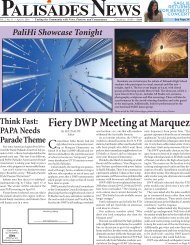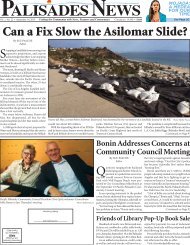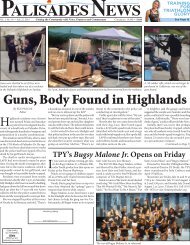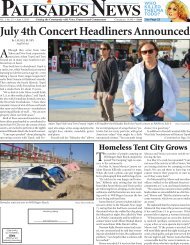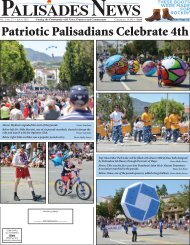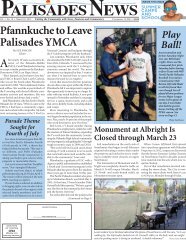Palisades-News-May-6-2015-
Palisades-News-May-6-2015-
Palisades-News-May-6-2015-
- No tags were found...
Create successful ePaper yourself
Turn your PDF publications into a flip-book with our unique Google optimized e-Paper software.
<strong>Palisades</strong> <strong>News</strong>Page 24 <strong>May</strong> 6, <strong>2015</strong>Skateboarding’s <strong>Palisades</strong> RootsBy LAUREL BUSBYStaff WriterPhotos courtesy of Don BurgessFifty years ago, skateboarding rolledinto the life of Don Burgess and thetown of Pacific <strong>Palisades</strong>.At the time, skateboarding was a newsport that developed quickly in Los Angelesin large part because of its similarity to surfing.In the 1960s, skateboarding was sometimescalled sidewalk surfing.Kids rode skateboards the same way theyrode surfboards, but skateboarding didn’trequire a parent to drive them to the beach.Instead, Burgess and other neighborhoodkids could walk somewhere like <strong>Palisades</strong>High School. The school had opened in1961 with a freshly paved, multi-level, hillsideparking lot that was ideal for skating.“It was just the perfect asphalt wave,” saysBurgess in his new documentary, Skateboarding’sFirst Wave. Burgess, an acclaimedcinematographer, made the movie to highlightthe sport’s local roots and its rise andfall in the mid-’60s.The 21-minute piece centers on the Pali -sades Skateboard Team, comprising a groupof kids who lived and skateboarded nearPaliHi. “It was the center of our lives at thattime,” Burgess said in a recent interview.Skateboarding’s First Wave was recentlyshown at the Newport Beach Film Festival,the <strong>Palisades</strong> Optimist Club and the SarasotaFilm Festival. The movie highlights adifferent time where kids roamed free andhad fun playing with speed and gravity ontheir clay-wheeled skateboards.Burgess, the cinematographer of dozensof movies, including Forrest Gump andSpider-Man, reunited 10 of the originalteam members at PaliHi last year to skateboardtogether one more time and also tocomplete interviews for the documentary.“Surprisingly, everyone could still skateboardpretty well,” said Burgess, whose sonMichael, a camera operator, shot the currentfootage. “When you spend that muchtime doing something when you’re young,it doesn’t ever leave you. Everyone still hadtheir same style and technique.”That style and technique, which Burgess’father originally captured on 16mm filmin the ‘60s, is the life-blood of the movie.Sometimes barefoot and always withouthelmets and pads, the kids obviously relishedcoursing down the PaliHi hill ingroups. They practiced tricks to add to thechallenge and the fun, like riding in a handstand,jumping over a rod or putting a bigmetal trash can on top of a board beforeriding downhill.Several girls joined the effort, as it wasMembers of the 1960s <strong>Palisades</strong> skateboarding club included (left) Peter Burg, (middle) Barry (Blenkhorn) Williams of Brady Bunchfame and (right) Chris Picciolo. Burg, who now lives in Colorado, provided the music for Skateboarding’s First Wave.one of the few sports they could participatein at the time. Little League baseball andPop Warner football were off limits.“Anyone who could do a handstand fromthe top to the bottom was in,” Burgess said.“It didn’t matter if you were a boy or a girl.”The team captain and oldest team member,Tim Keller, now a writer, photographerand teacher in New Mexico, was the inspirationfor the film in more ways than one.He wrote an article about the team for thePalisadian-Post in 2013. Burgess read theFifty years later, members of the <strong>Palisades</strong> Skateboard Team including: Don Burgess (front),Wendy (Bearer) Bull, Peter Burg (right) and in back Suzie Rowland Levin, Donna CashHarris, Tim Keller, Terry Keller and Tod Burton revisited the <strong>Palisades</strong> High School campus.piece, which prompted him to dig out hisfather’s home movies and re-watch them.“When I looked at the footage, it broughtall those memories back from 50 years ago,”Burgess said. “I wanted to go back and findout what happened to all these people.What are they doing? How had skateboardingaffected their lives?”Burgess set to work finding his old pals—most of whom he hadn’t seen in 50 years.Keller helped locate many, although noteveryone was still alive. Burgess brought thedocumentary idea to Red Digital Cinema,which stepped in to fund it.The result traces the roots of the team.One significant event occurred when the13-year-old Keller asked Burgess’ dad if hiscompany, Don Burgess Pools, would sponsorthem. Burgess senior readily assented.He bought team jackets for the kids andeven designed skateboards that used a materialthat reduces slipping in pools to helpthe kids stay on their boards.Burgess’ mother, Pat, designed the logoand even joined them sometimes on askateboard. Skateboard competitions ensued,and the kids did well against two(Continued on Page 25)




